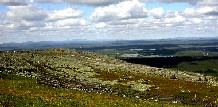LABLAND
Ecologically, Culturally and Visually Sustainable Urban Structure for Tourist Destinations (LABLAND)
LABLAND promoted ecologically, culturally and visually sustainable urban structures of tourist destinations
Landscape analyses of tourist destinations focused on aspects such as the following:
- Geology, landscape structure
- History of land use
- Visual landscape
- Soundscape
- Landscape experiences
Recommendations were draw up based on the analyses:
- Basic framework of a green area hierarchy based on the landscape structure
- Principles applied to landscape-based land use, landscape management and method of construction
- Indicators and monitoring areas depicting landscape change
According to the results of LABLAND –task, land use planning of tourist destinations should be interactive and based on knowledge of landscape factors. Landscape structure implies how susceptible a landscape zone is to the effects of different land use types. Analysis of green area structure and hierarchy is a relevant tool when studying the effects of different growth strategies. Geographical information systems (GIS) are usable in the management of multiple data sets in land use planning of tourist destinations.
Contact details:
Researcher
Marja Uusitalo
MTT Agrifood Research Finland
Plant production Lapland
B.O.Box16
96301-FI Rovaniemi
FINLAND
email: firstname.secondname@mtt.fi
Main publications:
Uusitalo, M., Sarala, P. & Tuulentie, S. (toim.) 2006 : Living tourism landscape. Landscape survey of the Ounsselkä region, and Ylläs and Levi tourist destinations (in Finnish with English summary) -Metlan työraportteja/Working Papers of the Finnish Forest Research Institute 33. 196 s.
Uusitalo, M., Sarala, P. & Jokimäki, J. (toim.) 2007 : Landscape-orientated land use planning in nature-based tourist destinations (in Finnish with English summary anf conclusions). -Arktisen keskuksen tiedotteita 49. Lapin yliopisto, Arktinen keskus. Painatuskeskus Finland, Rovaniemi, 88 s.